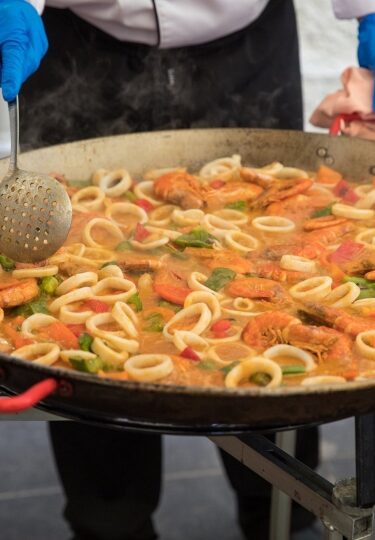Food in Barcelona is a major highlight in a city that’s also packed with extraordinary architecture, wonderful golden beaches, and world-beating art and culture. Lying in northeast Spain, in the warm glow of the Mediterranean, the city has access to some of the freshest produce from land and sea.
Barcelona’s streets are crammed with sun-dappled squares and side alleys lined with buzzing restaurants, fresh food markets bursting with Catalan produce, and some of the best tapas bars on the planet. You’ll find hole-in-the-wall style joints serving cava and light bites next to Michelin-starred venues conjuring up haute cuisine.
So once you’ve worked up an appetite wandering the Park Guell, lost yourself in the tangle of the Gothic Quarter and marveled at the Sagrada Familia, settle down to try these Barcelona foods.
Paella
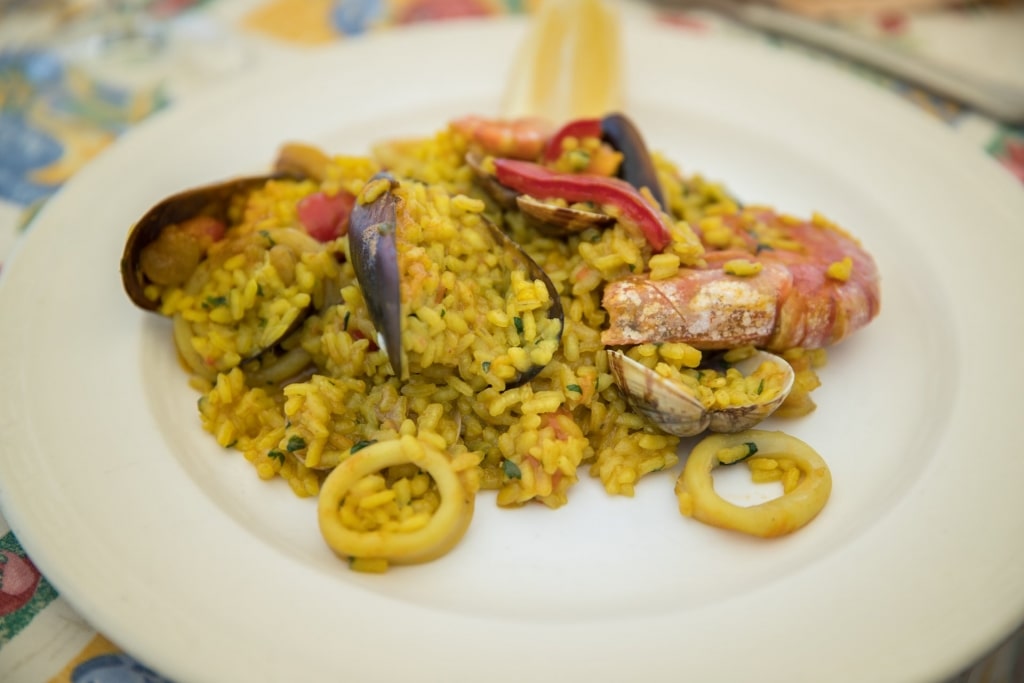
Paella
It’s impossible to talk about Barcelona food and not mention paella. Though the fragrant rice-based dish doesn’t originate in Barcelona, but comes from Valencia, to the south, it is a staple on the city’s menus. Flavored with paprika and saffron, and made in a large flat pan with rice, peas, stock, garlic, tomatoes, and sherry or white wine, paella is a must-try dish in Spain.
This humble dish came about in the 19th century, when farmers used rice from the Albufera lagoon in L’Albufera Natural Park in Valencia. Originally chicken or rabbit was added, but the dish has evolved to include seafood, too.
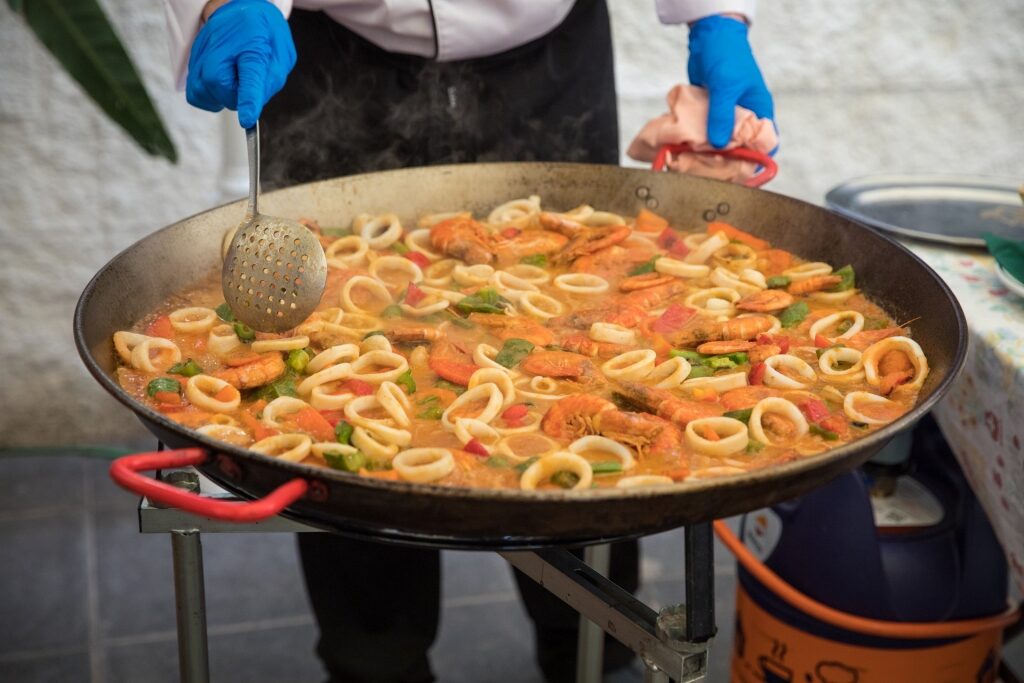
Paella
One of the best ways to enjoy paella in Barcelona is topped with seafood, including juicy shrimp, meaty squid, a delicious scattering of mussels, and slices of lemon. Try a paella cooking class to learn the secrets of making your own when you get back home. Many of the city’s culinary classes are combined with tours of the iconic Boqueria Market where you’ll be dazzled by the array of ingredients.
Croquettes
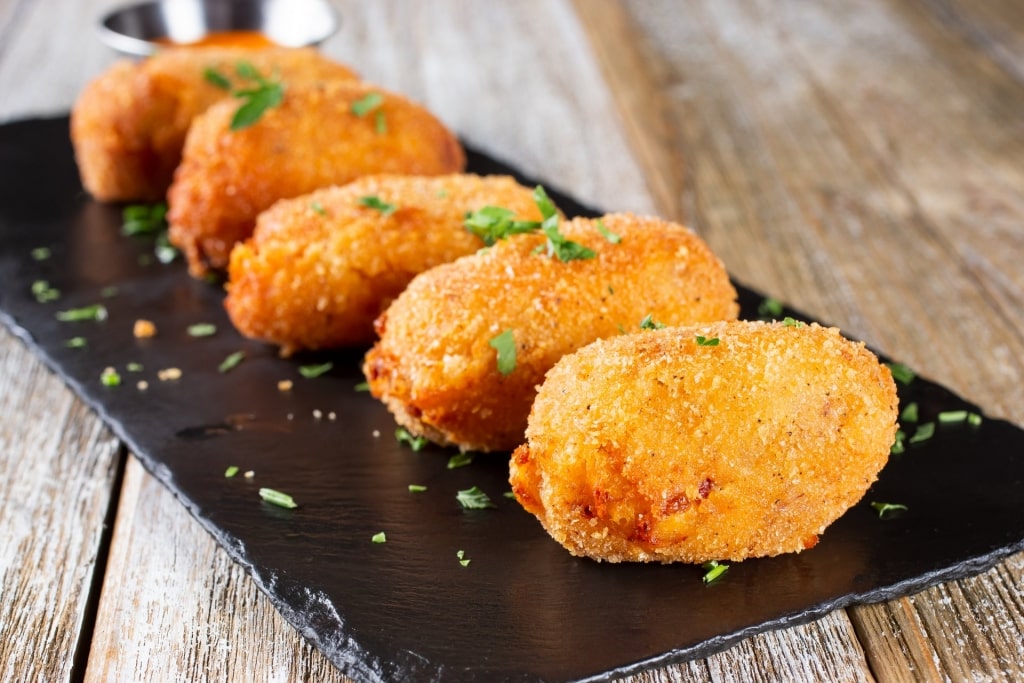
Croquettes
When deciding what to eat in Barcelona, do not overlook croquetas, or croquettes. This popular Barcelona food, served as part of an array of tapas, or as a larger dish, called raciones, is an appetizing blend of smooth bechamel sauce, ham, and mashed potato, coated in crispy breadcrumbs and deep-fried.
Historically, croquettes were made by using leftover ingredients, and adding some extra flavor through herbs or spices. You can expect to find garlic, onion, Dijon mustard, and even a dash of paprika to add extra bite to an already tasty dish. Sometimes, you’ll come across shrimp-flavored croquetas, or ham, or vegetables.
Find a pint-sized tapas bar on the vibrant Carrer de Blai in the central El Poble-Sec—one of Barcelona’s best neighborhoods—to enjoy these savory bites, which go well alongside a chilled beer.
Patatas Bravas
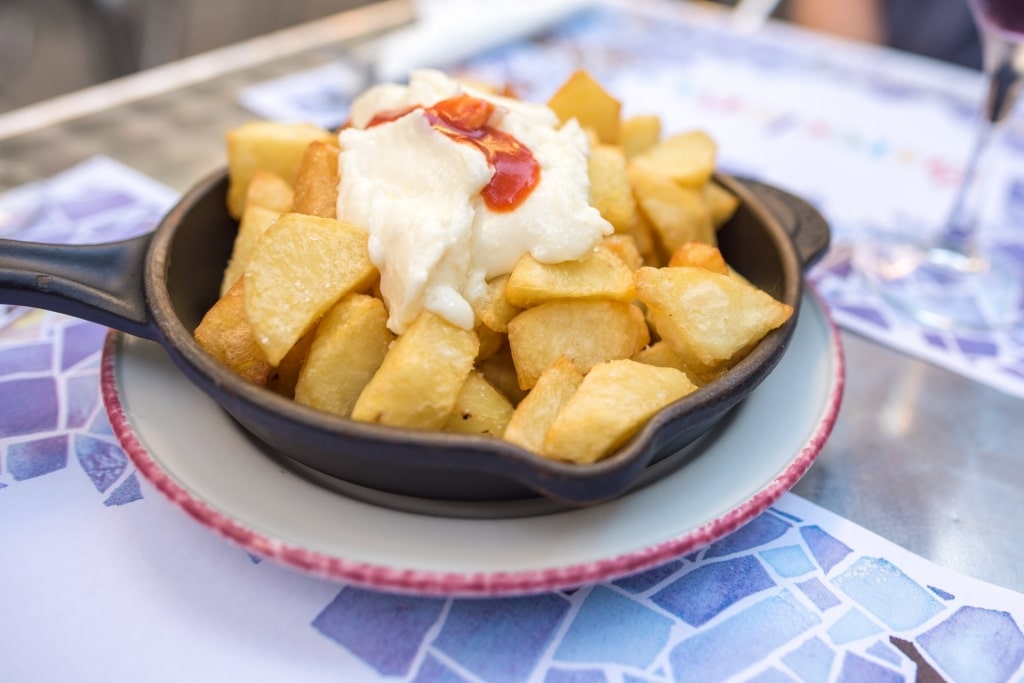
Patatas bravas
If you’re wondering what to eat in Barcelona, this potato-based tapas dish is a crowd-pleaser, consisting of twice-fried potato cubes served with a spicy bravas tomato-based sauce and a garlicky, lemony aioli. You’ve found a good-quality version of patatas bravas when the potatoes are soft and fluffy in the center and the edges are crispy, topped with a scattering of sea salt and rosemary.
A generous helping of flavorful bravas, combining tomatoes, sherry vinegar, onion, garlic, chilies, paprika, and fresh herbs, adds to the intensity of this umami-packed dish, with the aioli served on the side.
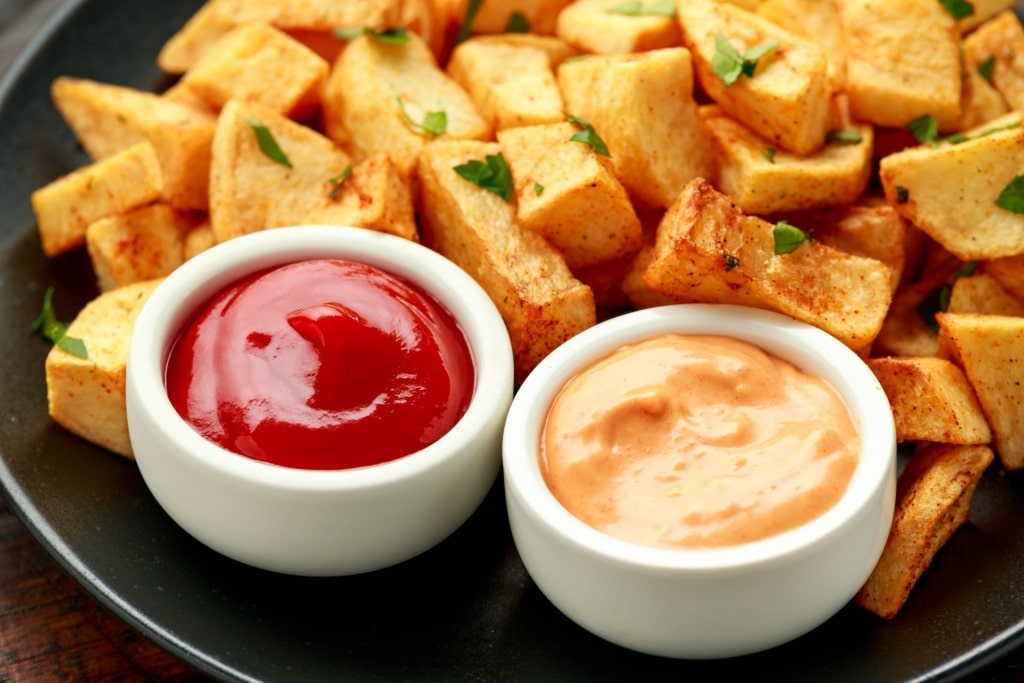
Patatas bravas
Though this moreish dish does not originate in Barcelona—that accolade goes to Madrid—it’s served in tapas bars, at markets, and restaurants around the city. Try bravas at Bar Tomás on Calle Mayor in the charming Sarrià neighborhood. It’s one of this tapas bar’s specialties.
You can eat them at the bar or at a table, served golden-brown in aioli or spicy sauce, along with the bar’s secret recipe sauce.
Jamon Iberico

Jamon Iberico
A satisfying platter of salty ruby-red Iberian ham, served in wafer-thin slithers and often eaten with slices of Manchego cheese, Jamon Iberico is a must-try Barcelona food.
Jamon Iberico is a traditional Spanish dish. This dry‑cured ham is a product of black Iberian pigs that are native to the Iberian Peninsula—and it’s one of Spain’s most famous dishes. The pigs roam free within farmland and feast upon the acorns from dehesa woodlands, mostly found in the Extremadura region of western Spain.
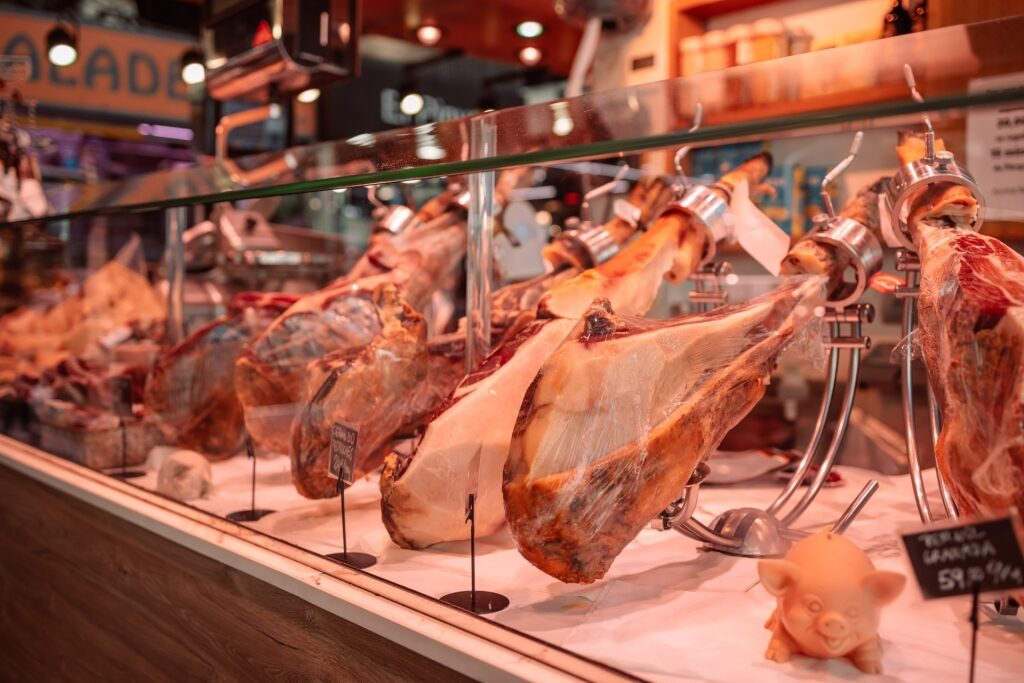
Jamon Iberico delicatessen
Visit a specialist Jamon Iberico delicatessen, such as Reserva Ibérica, with two outlets in the center of Barcelona, one on Rambla de Catalunya and the other on Avinguda Diagonal, for some of the finest ham around.
Reserva Ibérica sells ham from 100 percent Iberian pure-bred, acorn-fed, free-roaming pigs. The mouthwatering cuts of ham are only served once they’ve spent 30 to 60 months slowly curing. Notice the almost marble effect of the meat, with translucent lines of fat running through it.
You’ll see some ham labeled as pata negra, or “black hoof”, a specific breed of Iberian pig regarded as the finest of all.
Potato Bombas
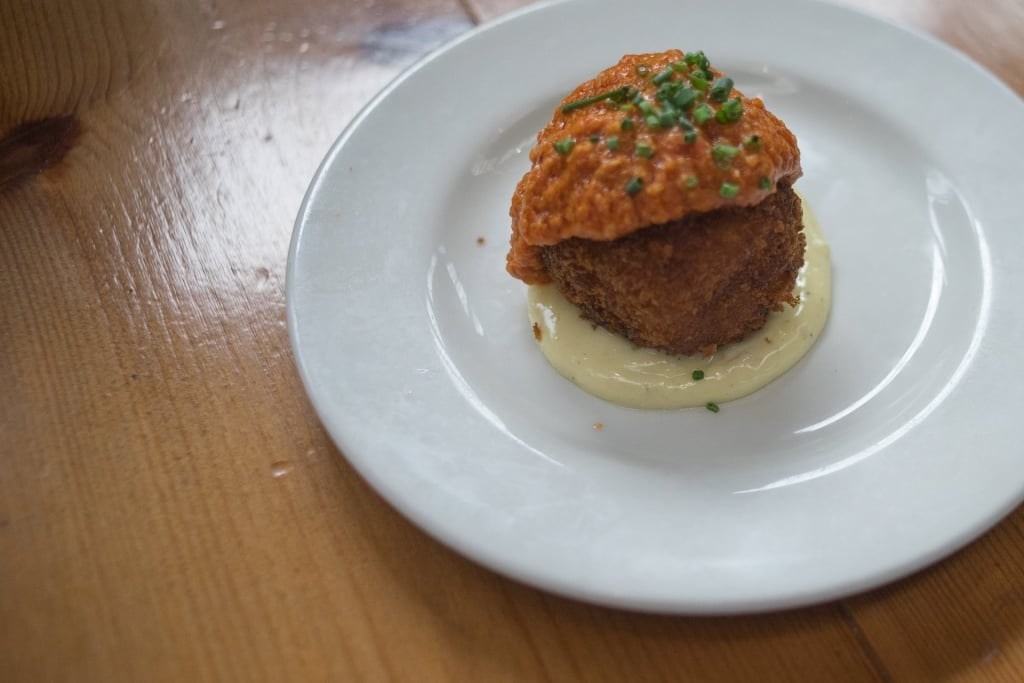
Potato bombas
Another tasty potato-based dish that you’ll find concocted in kitchens across Catalonia, potato bombas literally means potato balls, and are similar to croquettes in that the potato is mashed and deep-fried in breadcrumbs until golden.
The mixture is stuffed with various fillings such as ham, cheese, and chorizo. You’ll find them seasoned with a mix of herbs and spices such as peppers and paprika and accompanied by a sauce. Bite into these crunchy, flavorsome balls after dipping them in smooth, garlicky aioli.
A true Barcelona dish, potato bombas has its origins in Barceloneta, the city’s former, working-class fishing neighborhood, by the seafront. It is only right to sample it here, at La Cova Fumada on Placa del Poeta Boscà, a hole-in-wall-type joint where dishes including “Bomba,” sardines, and grilled artichoke are chalked onto a board.
Gazpacho
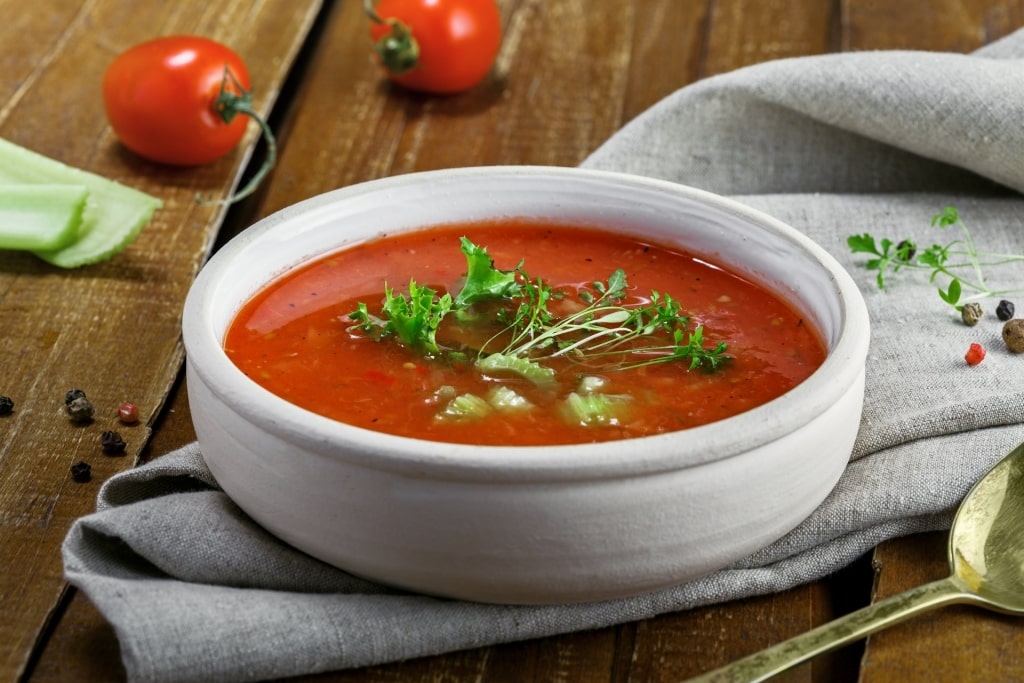
Gazpacho
If you’re craving a cooling, wholesome appetizer, go for gazpacho, a sharp, ice-cold soup that is one of the best things to eat in Barcelona. Originating in southern Spain, this staple Spanish summer dish uses extra-ripe tomatoes, bell peppers, garlic cloves, sherry vinegar, and extra virgin olive oil as a base.
Look out for different ways of serving gazpacho, for example in a shot glass as a palate cleanser or in a bowl filled to the brim as a lunchtime dish. Some versions of gazpacho include stale bread whizzed together with raw vegetables to create a thicker texture. If you prefer a smoother texture, opt for it without.
Gazpacho is an easy-to-make soup and one you can try your hand at when you return home. Perfect it at a cooking class with Barcelona Cooking, a cooking school. Located on the edge of the Gothic Quarter, steps from La Rambla, Barcelona Cooking teaches students how to create tortilla, pa amb tomaquet—or tomato bread—seafood paella, and Crema Catalana for dessert.
Escalivada
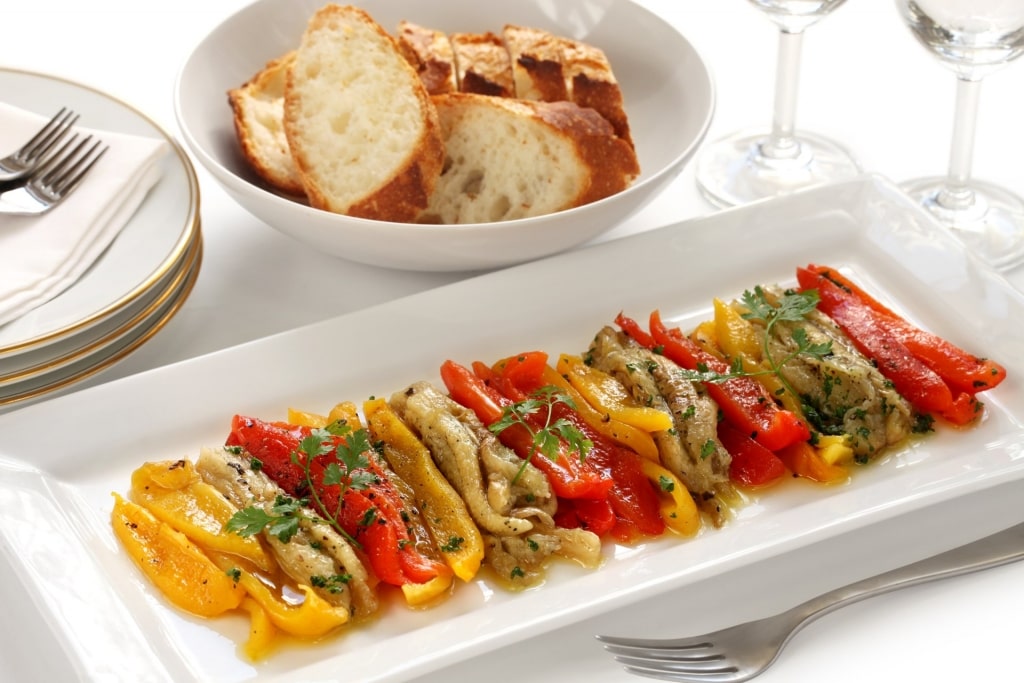
Escalivada
A simple Catalan dish of slow-roasted vegetables, often consumed as part of a selection of tapas, escalivada is a mix of bell peppers, onions, and eggplant, coated in olive oil and scattered with thyme and basil.
This Barcelona food is slow-roasted, with the market-fresh vegetables beautifully softened in the middle and charred on the outside. It’s eaten with fresh bread and can be served warm or cold. Escalivada is a great choice for vegans and vegetarians when visiting Barcelona.
Escalivada, which means “cooked over embers,” or to “cook in ashes,” has its origins in Barcelona. It is rustic, subtly smoky, and perfect as a tapa, alongside thick slices of bread at Cal Boter, a family restaurant that opened in 1986, a short 20-minute walk from the Sagrada Família.
Fideuà
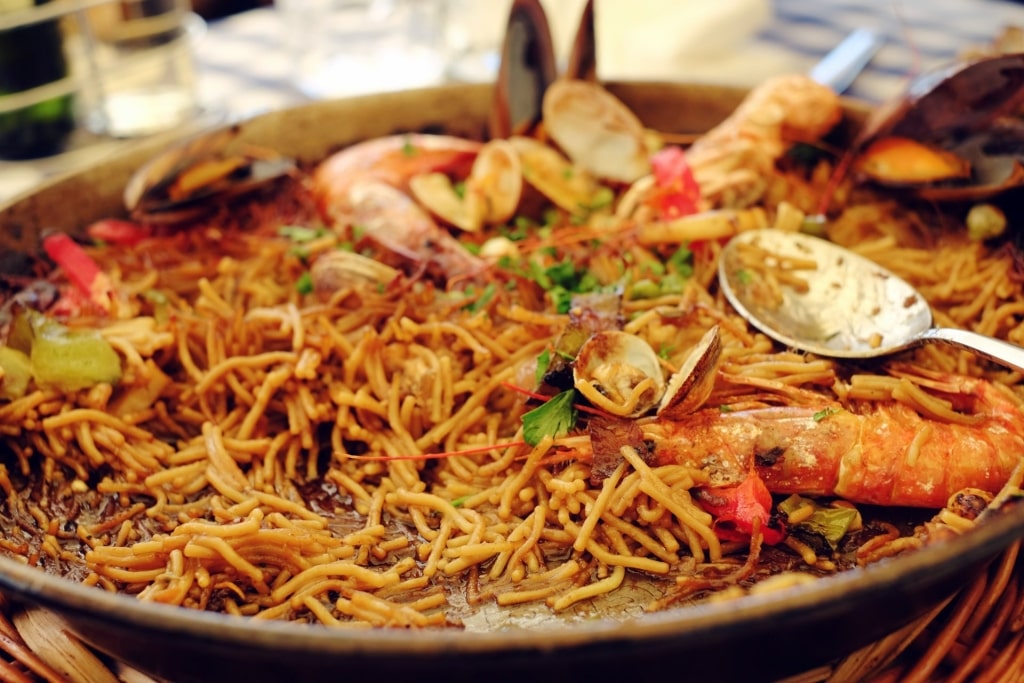
Fideuà
Another popular dish to try in Barcelona that originates in Valencia is fideuà. Similar to paella, this one-pot dish replaces rice with noodles, combined with garlic, tomato, bell pepper, saffron, fish stock, paprika, and seafood such as squid, shrimp, clams, and mussels.
Fideua is a feast for the senses, emitting rich and fragrant aromas presented with the shellfish on top. Let your nose lead you to a steaming pan of fideuà near Barcelona’s seashore.
Restaurants may vary what type of shellfish they add to the dish, depending on what is brought in fresh each day. The nautical-themed L’Amfora near Placa de España, follows a traditional recipe, with the dish topped with lobster, shrimps, clams, and flavored with a saffron aioli.
Spanish Cheese
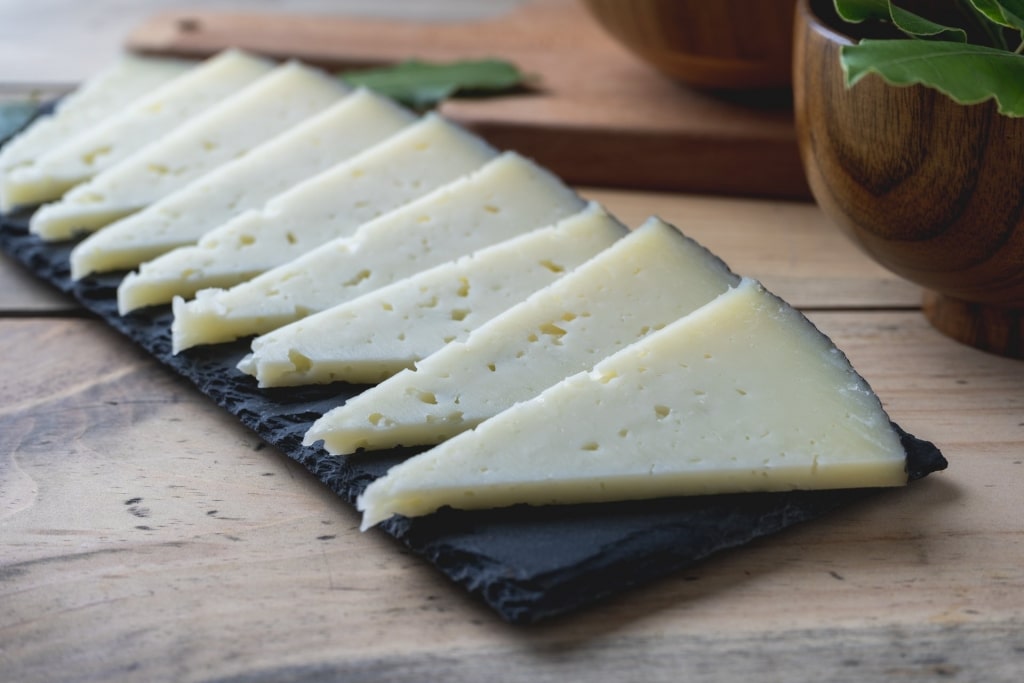
Manchego cheese
Spanish cheeses are among the best in the world and you’ll find a variety of them on most menus in Barcelona. Choose slices of nutty Manchego from La Mancha; a smoky Idiazábal from the Basque Country; a soft and creamy Mahón from the Balearic Islands, and a rich Roncal from Navarre, near the French border.
The harder cheeses, like Manchego, can be served with a honey dip for a delicious sweet and savory combination. Wash your slices of cheese down with a glass of refreshing Godello, a white wine from Galicia. If you’re a fan of silky sweet wine paired with cheese, treat yourself to a glass of delightful Lustau Pedro Ximénez San Emilio from Andalusia, with its standout raisin and fig tang.
Pa Amb Tomaquet
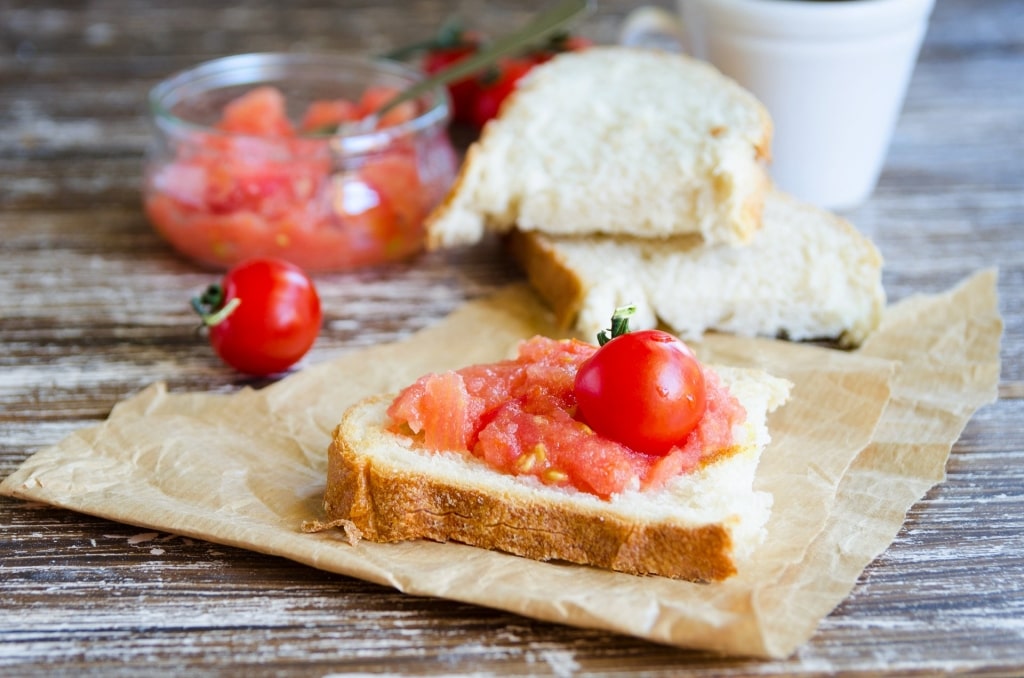
Pa amb tomaquet
If you’ve finished sightseeing and are pondering what to eat in Barcelona, look to this rustic, savory dish, the humble pa amb tomaquet, or bread with tomato. This is a staple throughout the Balearic Islands as well as in Cataluña.
Fresh bread is toasted and then rubbed with raw garlic, which delivers a wonderful kick. It’s then topped with grated, juicy tomatoes, drizzled in extra virgin olive oil, and sprinkled with sea salt. It’s a simple, finger-licking dish loved by locals and tourists, alike.
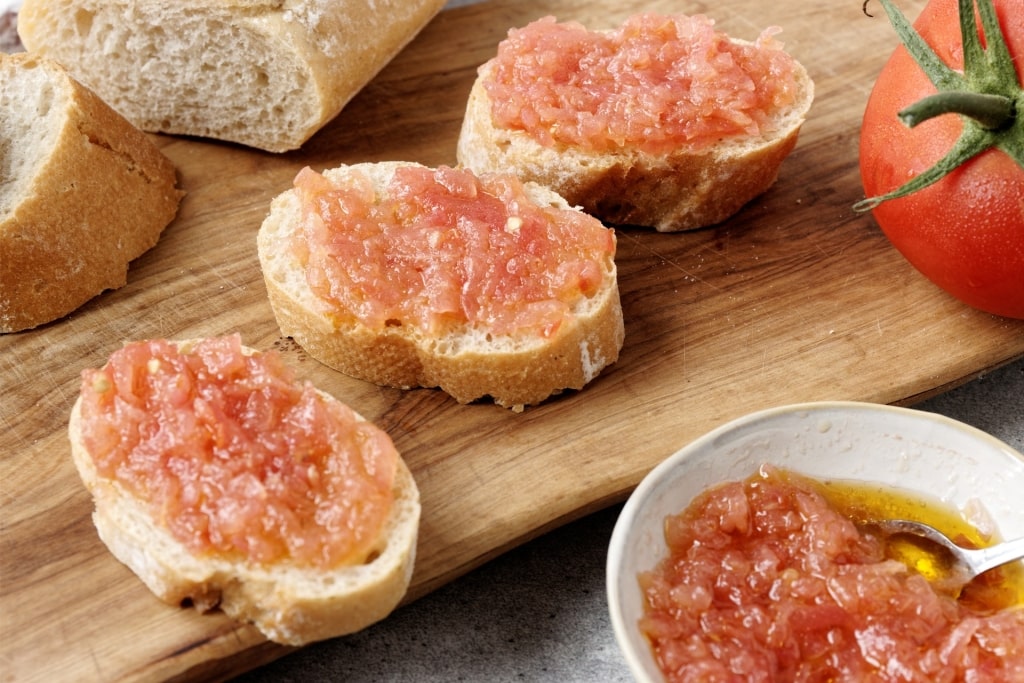
Pa amb tomaquet
Enjoy pa amb tomaquet any time of day as a meal on its own or part of a variety of tapas. You may find restaurants serve the ingredients on a platter, so you can assemble your own dish and enjoy the bread extra crunchy.
Savor it for yourself at La Boqueria market’s Paella Bar, where you could also order some of the best street food in Barcelona: patatas bravas, Jamón ibérico, croquettes, and a selection of paella dishes.
Padrón Peppers
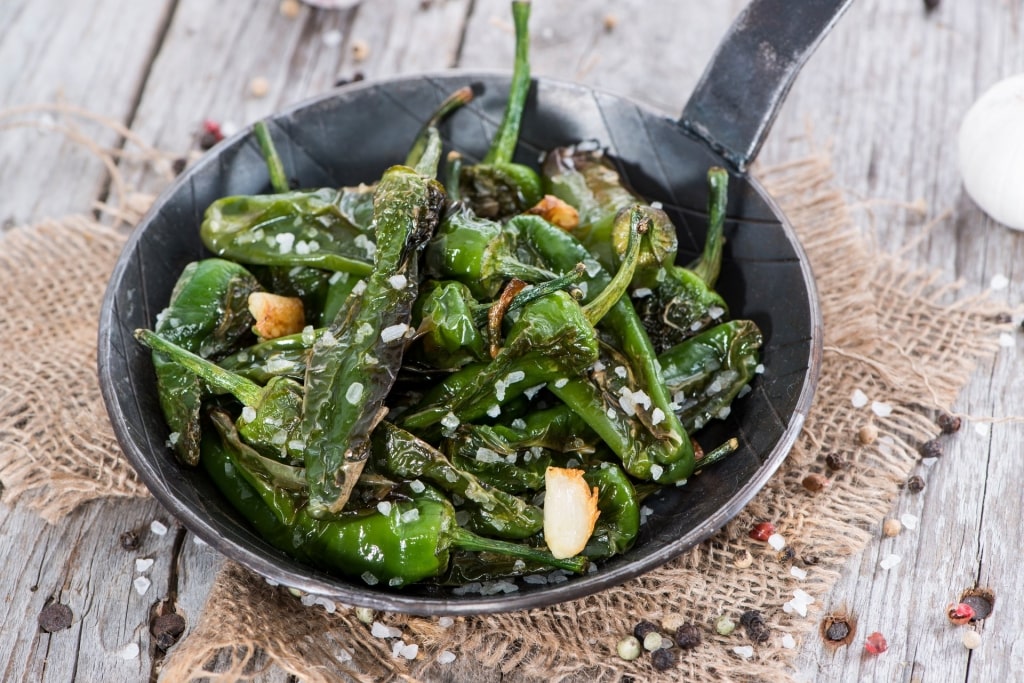
Padrón peppers
Sprinkled with salt, with a touch of olive oil drizzled over and blistered in the oven, these delicious, tangy morsels make a delightful tapas dish that is perfect for sharing. Don’t worry if you’re not a fan of extra-hot peppers. These green peppers from the Padrón region of northwest Spain don’t tend to be overly fiery.
If you’re feeling extra peckish, Padrón peppers pair wonderfully with fresh meaty fish dishes, such as swordfish and tuna.
You’ll find Padrón peppers on menus all over Barcelona, including at La Bombeta in Barceloneta, where the menu also features fried anchovies, dry-cured ham, and patatas bravas.
Esqueixada
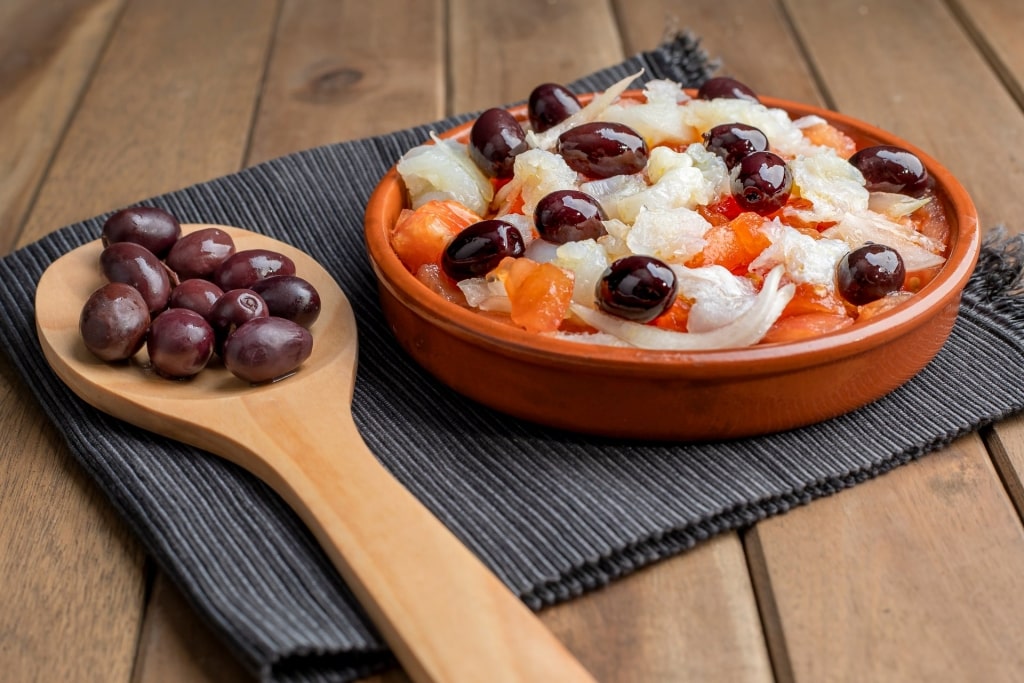
Esqueixada
Considered Catalan’s answer to ceviche, this traditional Barcelona food is a zingy salad of shredded salt cod—esqueixada translates as “shredded”—tomatoes, onions, black olives, and sometimes hard-boiled egg.
For a perfect summertime dish, order a refreshing plate of esqueixada with a thick wedge of bread and an ice-cold glass of the wine Spain is renowned for. Salt cod pairs well with the Galician wines, such as an elegant Albariño from Rías Baixas.
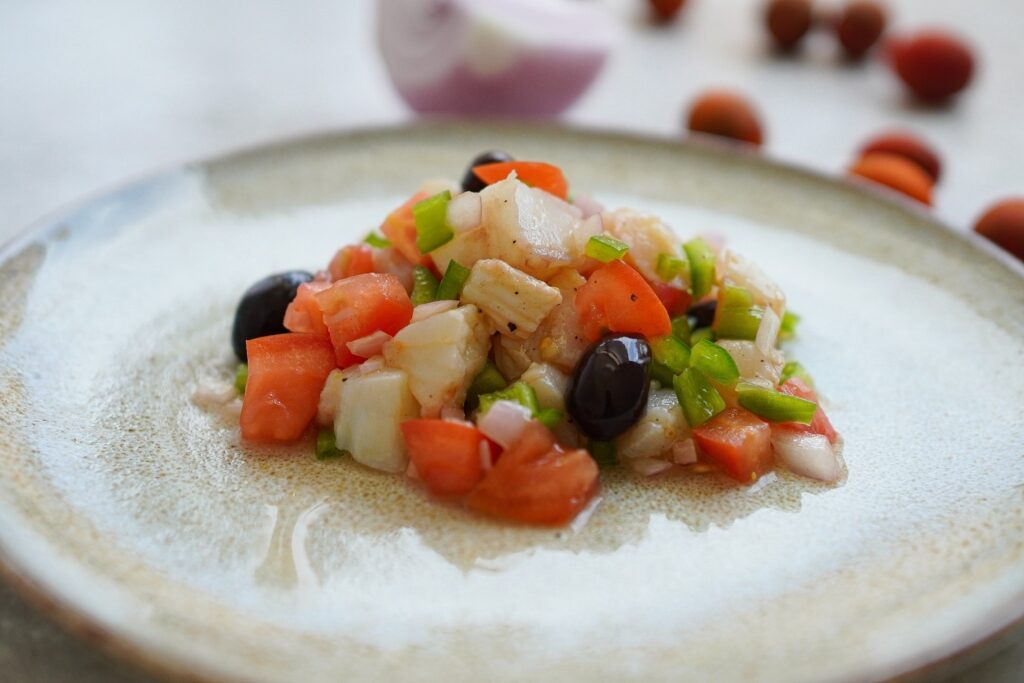
Esqueixada
Order esqueixada at La Barra Perelló—a cod tasting bar at Bacallaneria Perelló 1898—within Mercat del Ninot, a restored market that first opened as an open-air market in the 19th century. During the 20th century, the market became covered and later, restored and expanded.
Grilled Red Shrimp
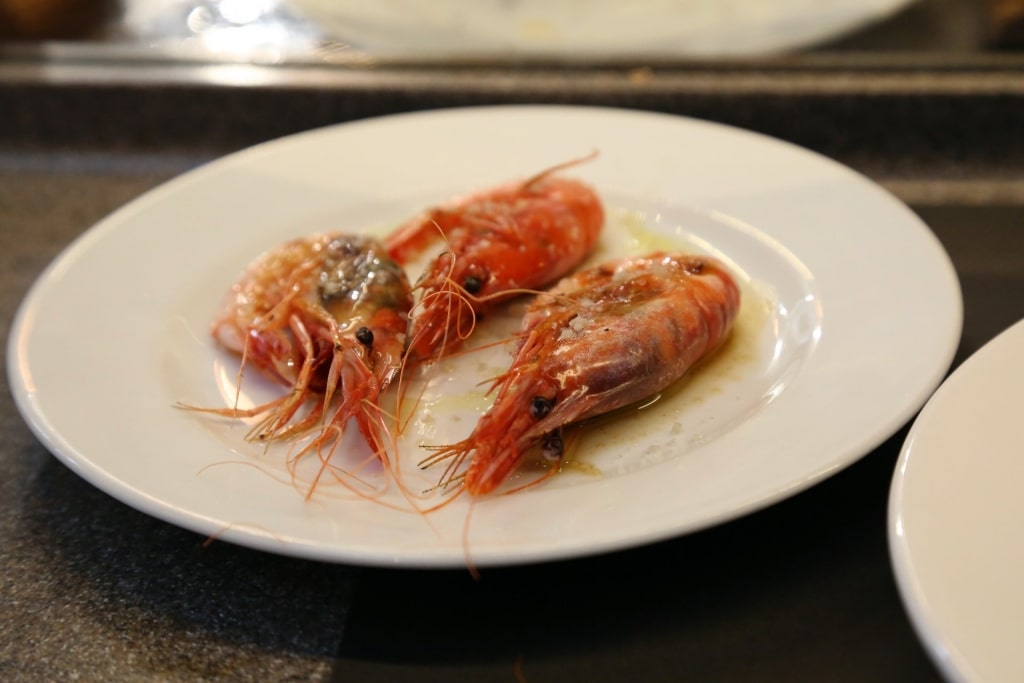
Grilled red shrimp
Take a stool at one of the seafood bars inside Barcelona’s famous La Boqueria market off La Rambla and prepare yourself for gamba roja, heavenly morsels of prized crustacean, harvested off the coast of Cataluña.
Before you settle on one spot, though, browse the market vendors’ overflowing crates of fresh fruit, vegetables, fish, cheeses, and preserves for gourmet gifts. Chains of dried chilies and hulking legs of Jamon Iberico hang from the stalls, adding to the atmosphere.
If you’re looking for an alternative spot away from the throngs of La Boqueria, Barcelona favorite Bar Cañete also serves a legendary portion of broiled red shrimp. Look out for the amusing name given to the dish on the menu: “Watch out for the red prawn that gets in at eight. Fresh from the sea to the plate.”
Do as the locals do and dine late at Bar Cañete, ordering plates of lobster croquette, spicy meatballs, and fried razor clams to accompany the sweet-tasting red shrimp.
Calçots
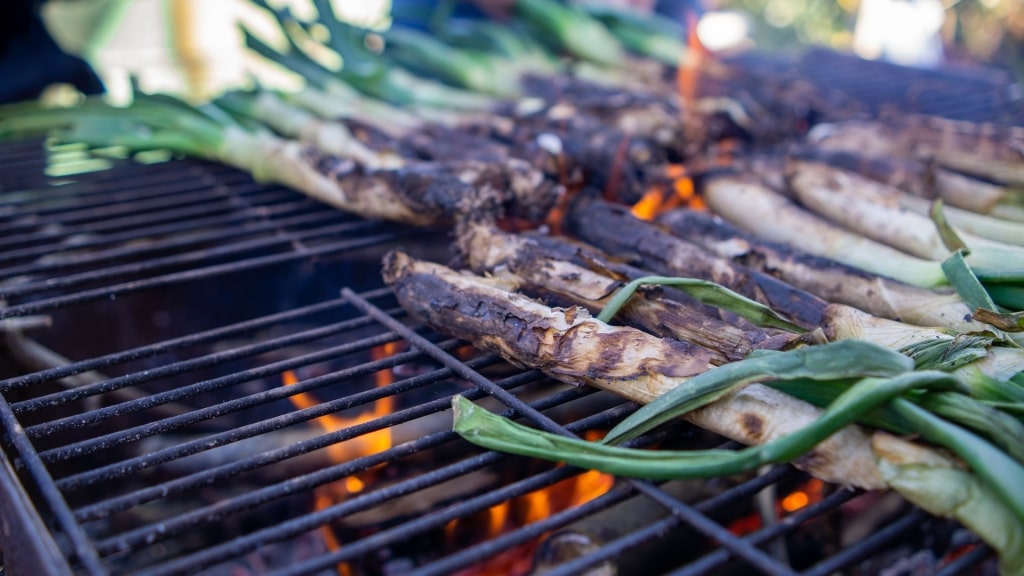
Calçots
This simple dish, pronounced “cal-sots”, is the Catalan name for scallions, also known as green onions and spring onions depending where you are in the world. The long, thin onions, milder than other types of onion, are char-grilled and served with a dip as a side dish with meat and fish.
Opt for a side of divine romesco sauce, a tomato-based dip featuring toasted almonds, garlic, smoked paprika, roasted bell pepper, and a dash of sherry vinegar.
So popular are calçots in Catalonia that many towns in the region celebrate the vegetable’s harvest, which occurs from December through March, with a festival, Calçotada. Some restaurants offer dedicated Calçotada menus during the harvest season, between November and April—though they are at their best from January to March.
Chipirones
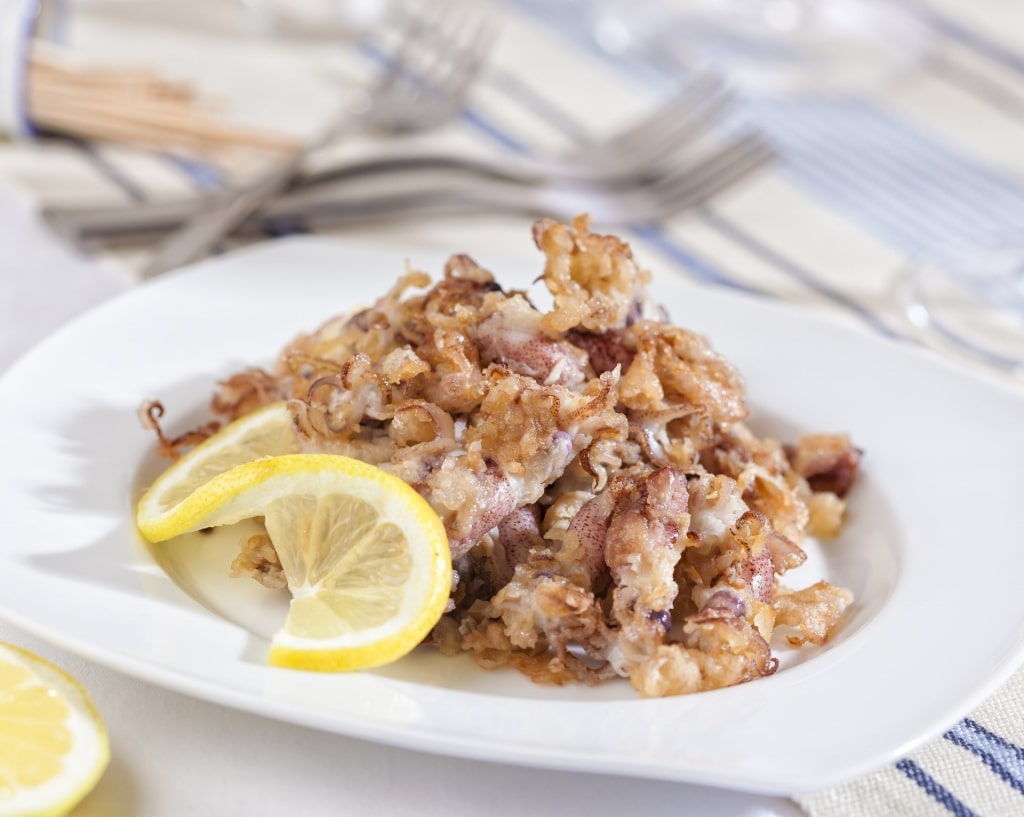
Chipirones
There are few better vacation foods to eat when in Barcelona, or anywhere in the Mediterranean for that matter, than chipirones, a delicious portion of delicately deep-fried baby squid. Squeeze the juice of a slice of lemon over the top for a zesty finish.
Graze this tender seafood dish at El Quim, another long-standing outlet at La Boqueria market, where the dish is served with crispy fried eggs.
Crema Catalana
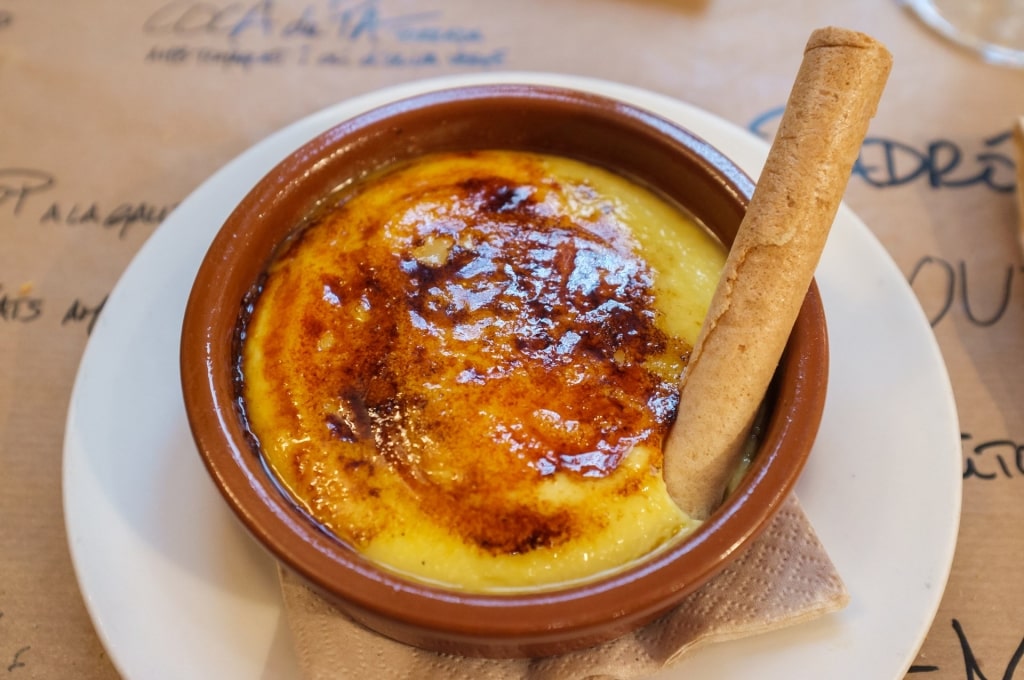
Crema Catalana
Barcelona is known for its gastronomy, and those with a sweet tooth should not miss this satisfying dessert. Almost identical to France’s crème brûlée, crema Catalana consists of an egg and milk-based custard with a toasted sugar top. The pleasure of cracking through the crunchy caramelized topping is almost as gratifying as the first exquisite mouthful. Don’t share a portion of crema Catalana. Order one entirely for yourself.
Interestingly, crema Catalana is thought to pre-date its French counterpart, crème brûlée, with the first recording of a crema Catalana recipe in the 14th century in the book “Libre de Sent Soví”.
Try crema Catalana, along with a frothy cappuccino at Granja Viader, a traditional cafe and deli on a narrow side street in El Raval that first opened in 1870, one block from La Rambla.
Chorizo
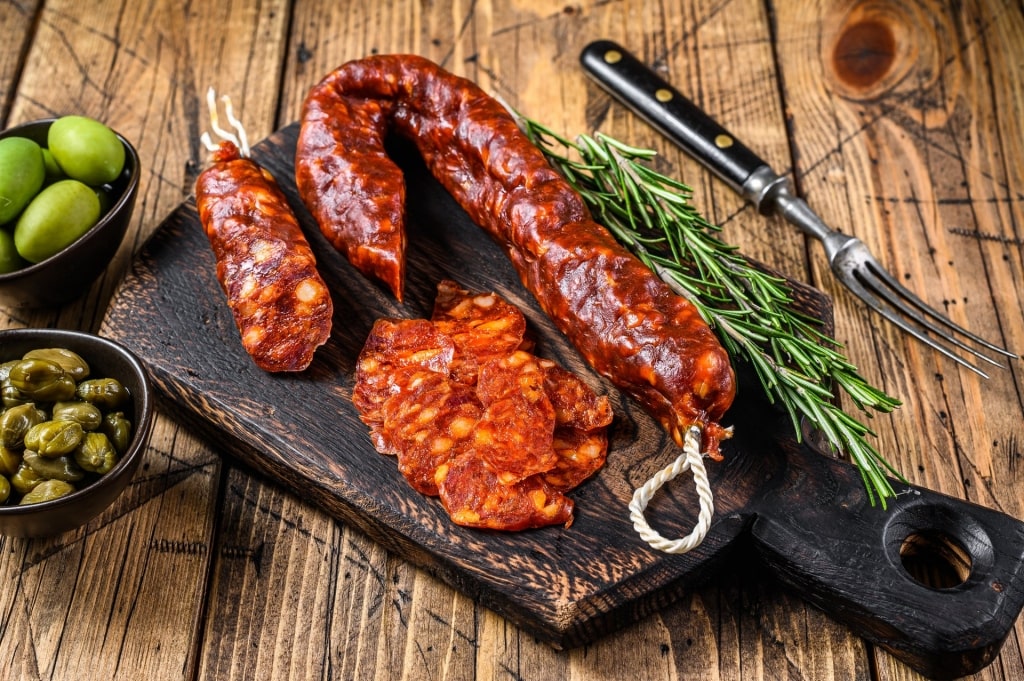
Chorizo
A paprika-infused pork-based sausage packed with lard, chorizo is one of Spain’s most famous meat dishes and has been a staple in Spanish dishes for centuries. This deep red-colored sausage is often cured, smoked, and found hanging from bars and market stalls across Barcelona.
Eat slices or cubes of chorizo, paired with Manchego cheese and a glass of punchy Spanish wine. You’ll find chorizo used in tapas dishes, stews, paella, and filling hearty sandwiches.
Call by Colmado Murria, a grocery store, charcuterie, and restaurant that opened its doors in 1898, close to Plaça Catalunya, in the center of Barcelona. Here you’ll find a delicious selection of artisan sausages, as well as cheeses, coffee, and wine.
Tortilla de Patatas
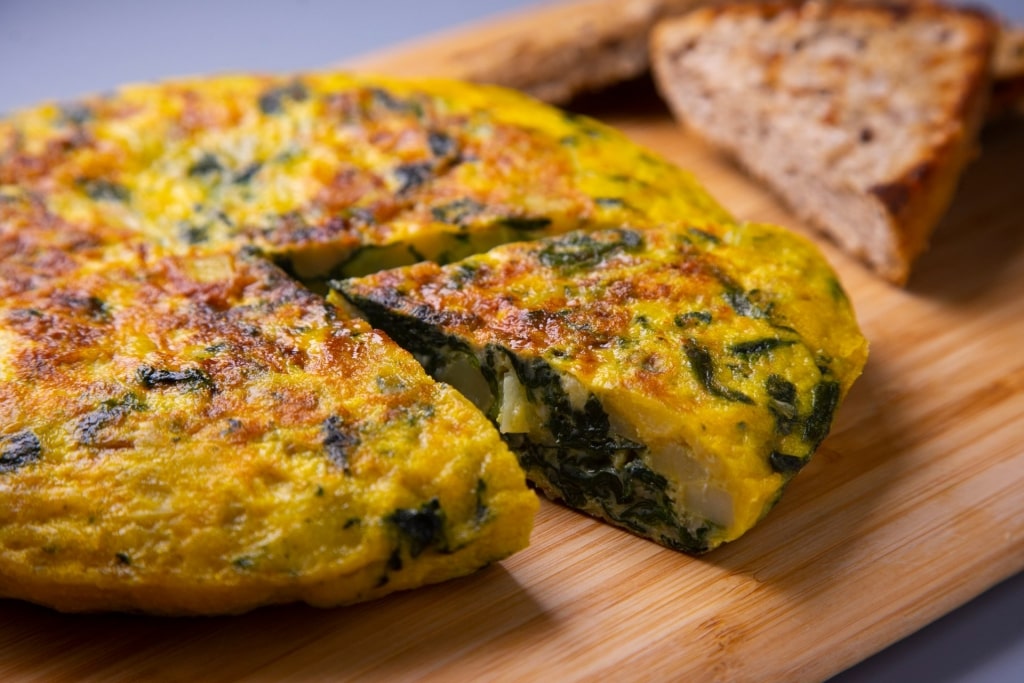
Tortilla de patatas
If you’re craving comfort food, hunt down a tortilla de patatas, also known as a Spanish omelet or Spanish tortilla outside of Spanish-speaking regions. Thought to have been concocted around the late 18th or early 19th century, this satisfying, uncomplicated dish is made with eggs, potatoes, and typically onion, olive oil, and sometimes a scattering of fresh flat-leaf parsley for garnish.
Eat a slice of tortilla de patatas hot or cold, as part of tapas or on its own. Fans of this savory dish flock to Les Truites in L’Eixample, which is famous for its vast selection of tortillas. Some are packed with potato with Iberian chorizo, others with brie, caramelized onion, and potato, and tortillas that ooze with cheese and truffle.
Cava
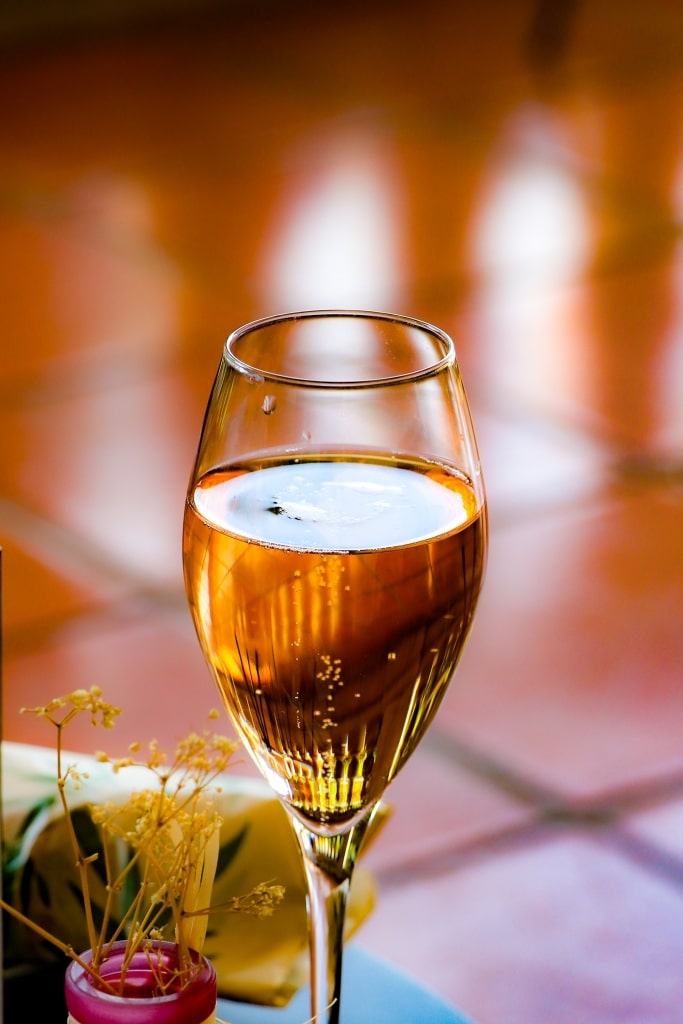
Cava
When you’ve finished a busy day of exploring or an afternoon lazing on Barceloneta Beach—one of the best beaches in Barcelona—find a charming bar, such as Can Paixano near the port, and order a glass of fizzing cava, Spain’s treasured sparkling wine. Can Paixano has been in business since 1969 and specializes in cava, with a shop selling some of the region’s top brands.
Produced in Cataluña, cava is an elegant and easy-to-drink wine, typically dry and earthy in taste, though sweeter and semi-sweet varieties can also be found. Many sparkling wine drinkers even prefer cava to Champagne for its sharp effervescence. If you’re looking for fizz with more depth than a typical white, try a blush cava, such as Anna de Codorniu Rose Brut or Vilarnau Brut Reserva Rosé.
If your schedule allows, head to the Codorníu Cellars. A 40-minute drive from Barcelona, Codorníu Cellars is the revered home of one of the country’s oldest wineries. Codorníu offers experiences including tours of the ancient winery, wine pairings, and a cava tasting beginner’s course.
Churros
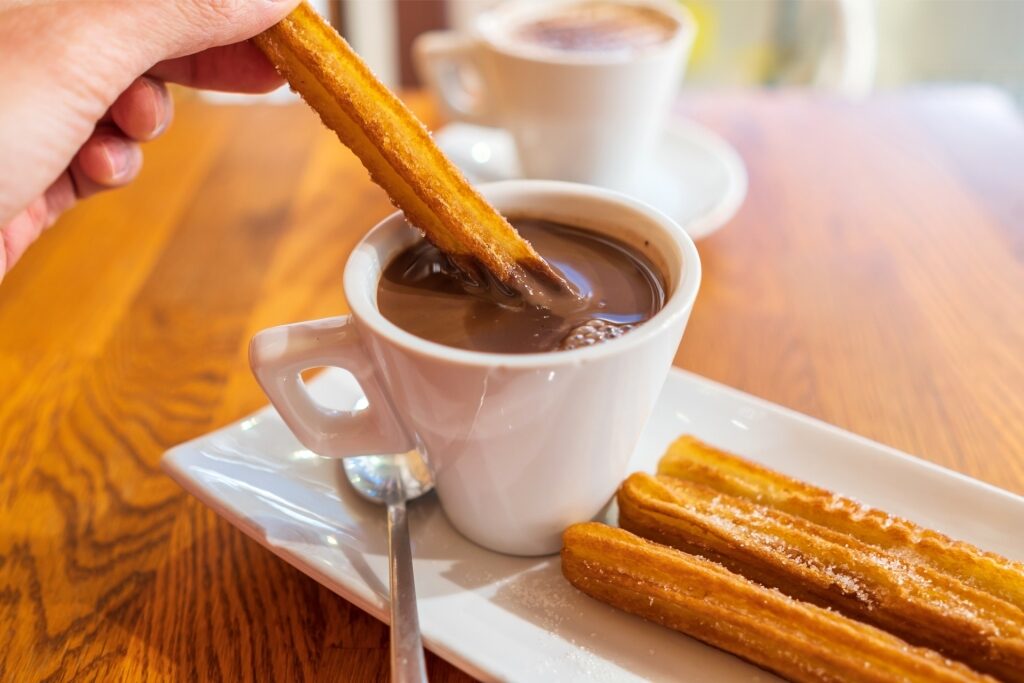
Churros
Sweet-toothed travelers love to chow down on churros, the ultimate sweet comfort food in Barcelona. This deliciously sweet breakfast dish can also be eaten as a snack or a dessert and it is, essentially, a donut.
Churros are made by frying choux pastry that’s piped into a long and thin shape into hot oil. Once fried, churros are sometimes coated in sugar, sometimes served without, accompanied by a hot chocolate sauce or dipped into coffee.
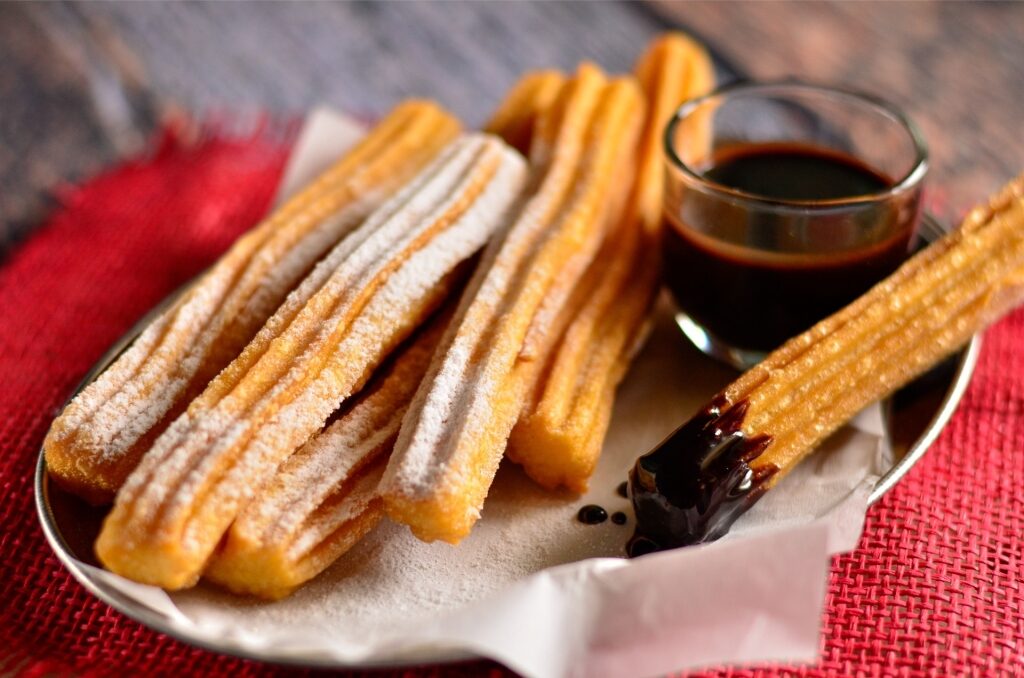
Churros
Churros’ origin isn’t exactly clear, though one theory is that Spanish shepherds developed the dish as an inexpensive substitute for other bakes.
For gourmet churros, visit Artchur, a few blocks from Plaça de Catalunya, in L’Eixample. Here the menu extends to offer churros with a variety of sweet-flavored creams and ice cream, such as pistachio and matcha tea, to savory-options with churros served with gooey cheese and guacamole.
Read: 3 Days in Barcelona
Arròs Negre
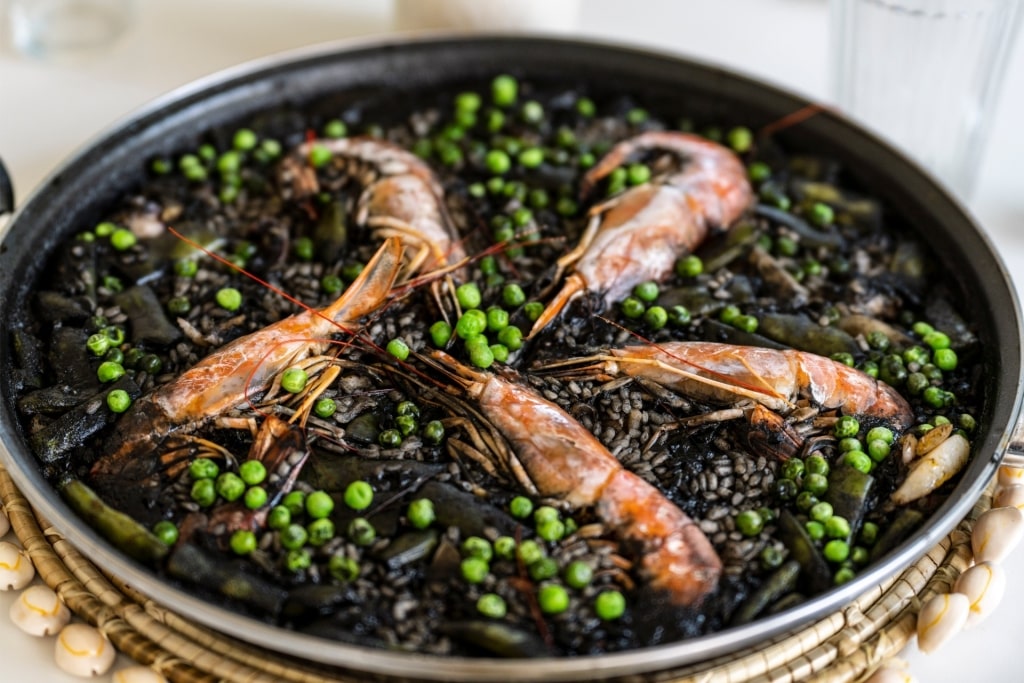
Arròs negre
This striking Catalan and Valencian dish is similar to paella, made from squid or cuttlefish and rice, with its black color coming from squid ink used in the dish. The recipe also includes garlic, green peppers, paprika, olive oil, and seafood broth or stock. You might find variations with shrimp, clams, and other seafood added.
This richly flavored dish is cooked in a wide, shallow pan, just like paella, and will be served in the same pan, usually with wedges of zesty lemon.
Find a waterfront restaurant where you can feel the warm Mediterranean breeze to try arròs negre. Close by Platja de la Barceloneta, Can Majó serves a modern take on this classic dish, with black truffle, shrimps, and Galician Clams.
Botifarra amb Mongetes

Botifarra amb mongetes
This simple Barcelona dish consists of sausage with beans and originates in pastoral Catalonia, where it would be prepared in farmhouses, at vineyards to feed workers, and in rural homes.
It might not be the prettiest of dishes, but it exudes comfort and is inexpensive to make. First, the beans are boiled, the sausage pricked with a fork then sauteed in a pan. Once the sausage is cooked it can be set aside and the beans are then sauteed in the sausage fat before serving on a plate, with the sausage on the side of the beans.
Try this wholesome dish at Can Culleretes, a Gothic Quarter institution that opened in 1786 and is likely Barcelona’s oldest restaurant.
FAQs
Are there vegetarian or vegan options in Barcelona?
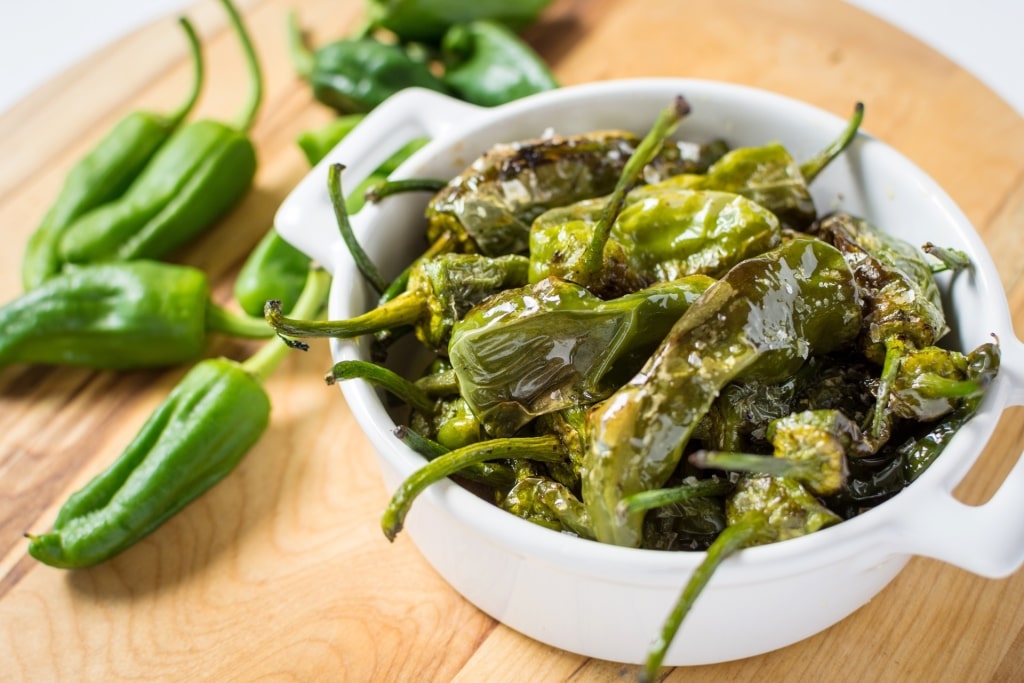
Padrón peppers
There are plenty of vegetarian and vegan options to try in Barcelona, including some of the aforementioned dishes, such as Padrón peppers, escalivada, and patatas bravas.
You don’t need to miss out on classic Spanish dishes such as paella, either. Simply ask your server for a vegetarian option, which arrives without seafood or chicken. Just check the dish is made with vegetable stock, not meat or fish stock.
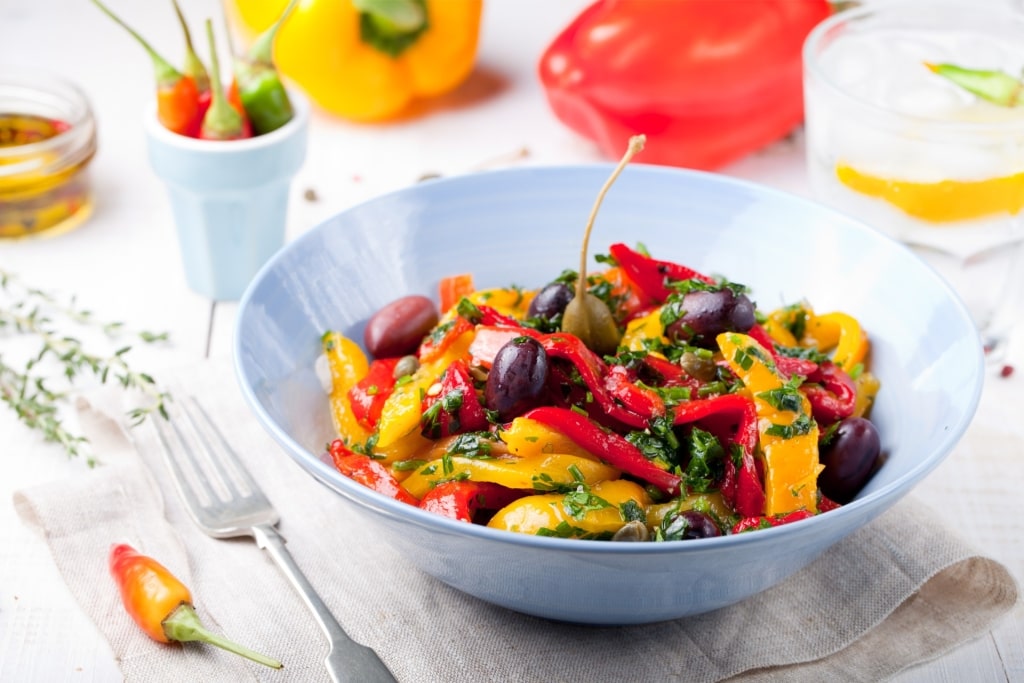
Escalivada
There are some knockout vegetarian restaurants in Barcelona. Check out Teresa Carles, close to La Rambla, in El Raval. This cafe and deli serves mushroom croquettes, vegan bomba de la Barceloneta—potato bombas without meat or animal products—and on a hot day, the refreshing mango and avocado tartare and gazpacho with a touch of cumin are delightful.
Sésamo is an outstanding vegetarian restaurant near Mercat de Sant Antoni where seasonal dishes appear like works of art, including asparagus on a romesco sauce, with roasted hazelnuts, cherry gazpacho, and roasted cauliflower paired with tahini, salsa verde, pomegranate, and pine nuts.
What is the typical cost of dining out in Barcelona?

Restaurant in Spain
The cost of dining out in Barcelona all depends on the venue you opt for—budget, mid-priced, or fine-dining.
Prices run the gamut from the inexpensive—such as cones of cheese and Iberico ham at market stalls, where you might pay around €10—to tasting menus that cost hundreds of dollars, or euros in Spain.
Expect a meal at a mid-priced restaurant to cost €25-50 per person. At tapas restaurants, individual items start from around €5 and run to around €15 per dish. You might pay around €20-25 euros for a plate of the finest acorn-fed Iberian ham; and a similar amount per person for paella dishes.
Tasting menus at Michelin-starred restaurants can run into the hundreds of euros. Disfrutar, one of Barcelona’s, and indeed Spain’s, most famous fine-dining restaurants, costs €315 per person, without drinks or tips. Wine pairing is an additional €170.
How do I avoid tourist traps when choosing restaurants?

Pintxos bar in Barcelona
There are a number of things you can do to avoid tourist traps. First, consider avoiding restaurants on the most central strips, such as La Rambla and near the Sagrada Família. While La Rambla is a scenic stretch, and close to many of Barcelona’s best sights, the restaurants are more touristy than those you will find in other neighborhoods.
Other things to look for when deciding where not to eat are waiters touting for business outside, plated dishes left on stands to advertise the menu or photos plastered outside of restaurants.
Also, check review sites for honest customer feedback.
Is there street food?

Gothic Quarter
Barcelona’s equivalent of street food culture can be found in its endless tapas bars, hole-in-the-wall spots, and vibrant food markets. At Time Out Market Barcelona, for example, you will find a food hall with a cornucopia of stalls that whip up some of the best Catalan and international cuisine.
Similarly, at La Boqueria, you can pick up cones of delicious Iberico ham, fresh fruit smoothies, fried fish, and olives.
What dining etiquette should I be aware of?
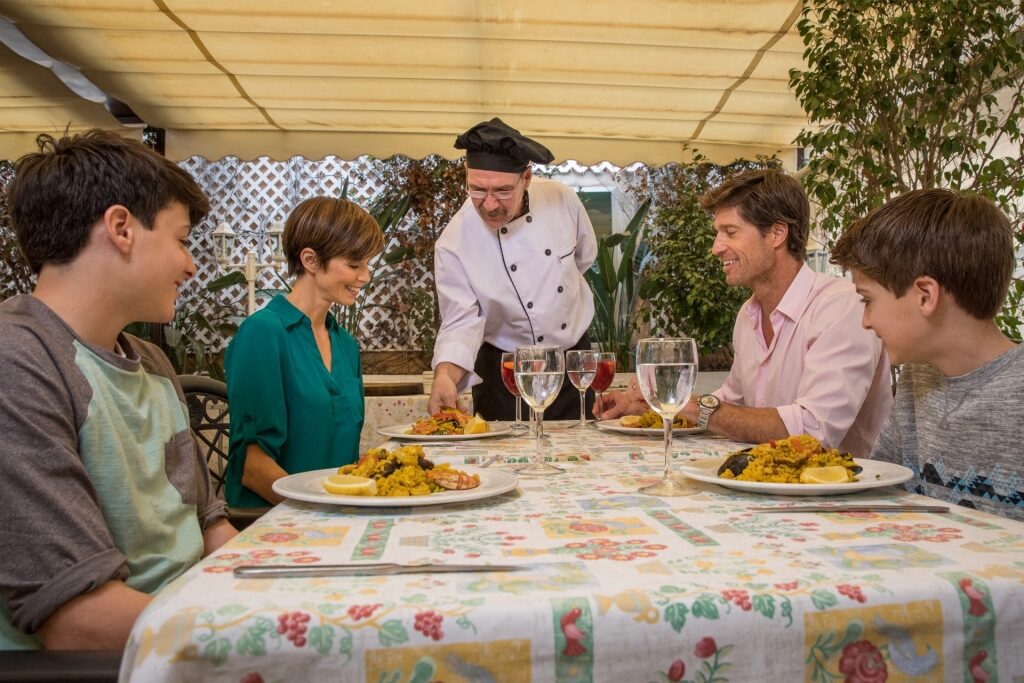
Restaurant in Spain
Always greet restaurant staff, from servers to bar persons, with a polite “Hola, buenas,” which means hello, good day, and “Gracias,” for thank you, when you have been served.
Typically, at any restaurant, you should wait for a waiter to seat you and not assume a table is available. At a café or more casual tapas bar, you can simply take an available table, or ask, ¿Está libre esta mesa?, which means Is this table free? in Spanish.
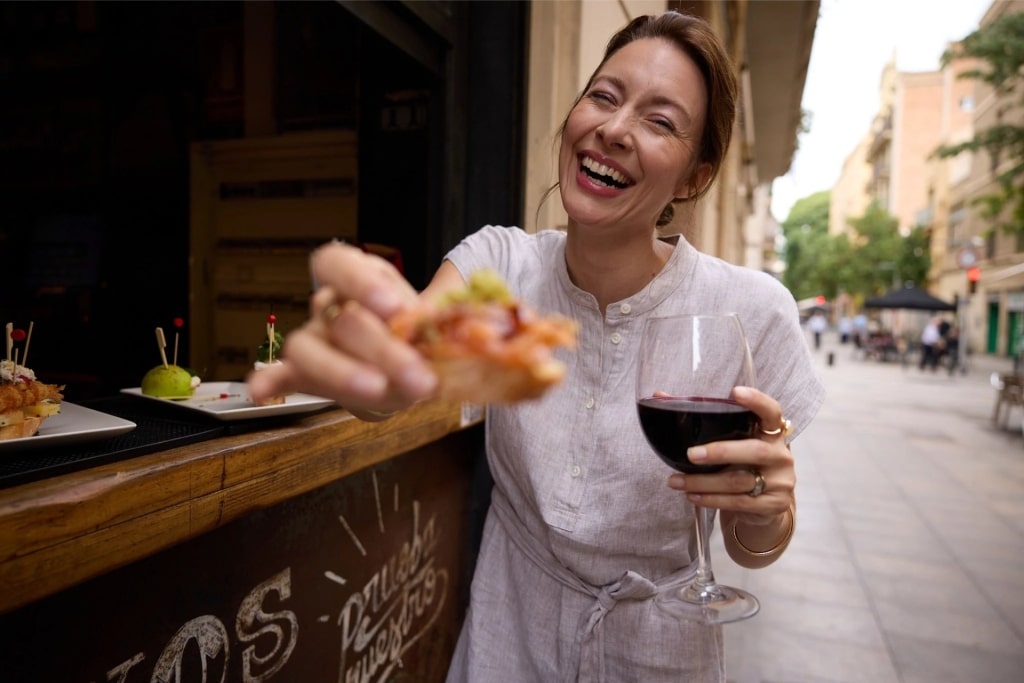
Pintxos bar in Barcelona
It is becoming more the norm to tip when dining in Barcelona, though Spain does not have the same tipping culture as in North America. Tips, or service charge, are more appreciated than expected. Look for “servicio incluido” on bills, which means service is included.
If you are satisfied with your meal, the service, and the overall ambiance of the restaurant, or other venue, feel free to round your bill up and leave a small note or coins as a tip. Naturally, for larger bills, such as when dining at an exclusive, fine-dining restaurant, you may want to tip more.

Barcelona
Taste your way around the city on one of Celebrity’s culinary and culture-packed cruises to Barcelona. Browse itineraries and start planning your next foodie vacation today.
